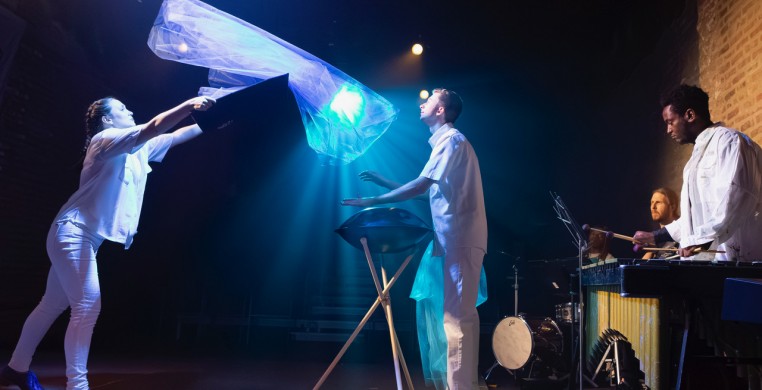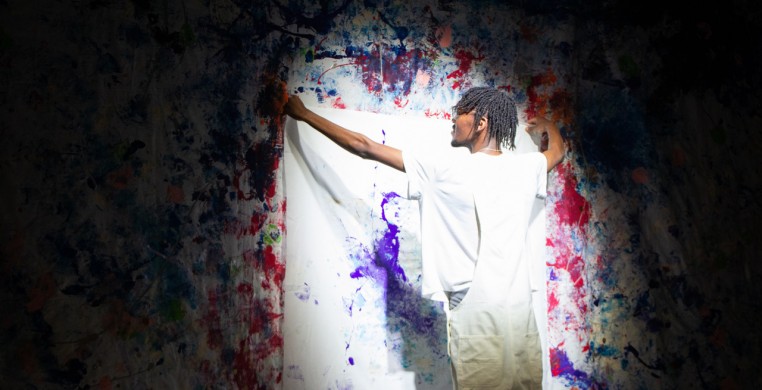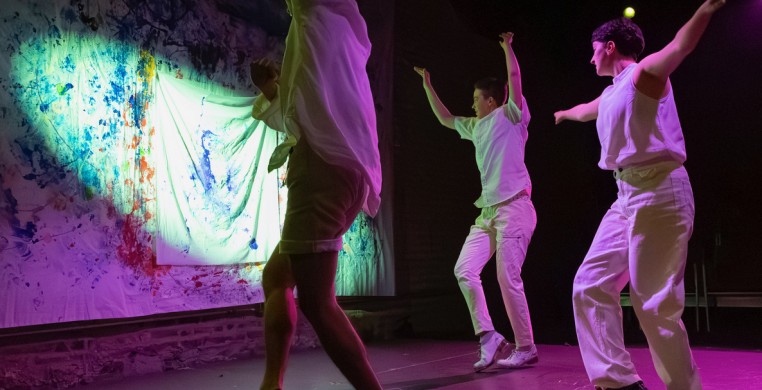A “synesthete” is someone who associates one sensory quality to describe another; For instance, if someone says that the syncopated rhythms of a tap dancer filled the stage with swirling colors and bright lights, that would be a synesthete.
The goal of Chicago Tap Theatre’s recent production, “Synesthete,” is to get audiences to associate tap dance with more than just sound and movement, but also colors, light and smoke. “Synesthete” is the brainchild of Director, Choreographer and company Artistic Associate, Sterling Harris, a compilation of twelve short pieces, with additional choreography by Founder and Artistic Director, Mark Yonally, and company member, Molly Smith. The performance features vibrant lighting design by Hannah Wein, sound design that integrates spoken word over jazz standards by Aaron Gottl and a live jazz combo conducted by Thaddeus Tukes.
The theater spacing is interesting, with the audience sitting on risers placed on opposite sides of the stage. In the center is the square, wood dance floor. On one side is the band; on the other side, a large drop cloth coated in swoops and squirts of colorful paint hangs against the wall, a rectangle in the center left blank.
As the lights dim, a thick haze aggressively rolls over the audience. Voiceovers of tap dance luminaries Gregory Hines and Diane Walker speak in aphorisms—“Tap dancing is like the music, you gotta hear it.”
 Dancers from Chicago Tap Theatre performing in "Blue"; Photo by William Frederking
Dancers from Chicago Tap Theatre performing in "Blue"; Photo by William Frederking
The show opens with some improvisation. Awash in beams of deep magenta, dancers take their places in a circle and trade spontaneous rhythms with Tukes on the vibes over a smooth rendition of Ahmad Jamal’s “Moonlight in Vermont.” The jam culminates in a swinging solo by Yonally to a waltzing “Boogie Nights” by Heatwave. Improvisation is sprinkled throughout the performance, giving each member a moment to shine.
The allusion to color is central to the work. In “Blue,” the band playing Tears for Fears’ “Everybody Wants to Rule the World” IS accompanied by dancer Chris Matthews playing the hand pan’s jewel toned notes as dancers ripple of spins produces sustained, scratchy drags in the feet.
The work expands in “Yellow” and features a compilation of fun and funky tunes while dancers present all manner of imagery—a cordial lindy hop break, a nail-biting session where dancers do cramp rolls and wings while avoiding a long, swinging jump rope, references to 1940s-era social dance moves like the shorty George and broken-knee sugar twists. Although mixed styles in tap often come off as hokey, the kicks, twists and smiles here are loose, fun and genuinely integrated.
A suite, “Orange,” Black” and “Green,” features music by John Coltrane, Mongo Santamaria, The Stylistics, Jazzmeia Horn and Chicago artist Macaya McCraven. Dancers appear in bars of light like an imprisoned subterranean tap dance cult worshipping to a funky bass line. They rotate in a circle, feet plucking out accents as they crawl—toe, TOE, heel, heel, Toe, toe, heel, HEEL… The mood and music shift as the lights go out and the band lilts into a bouncy 5/4 meter. Several dancers, shining flashlights, play follow the leader while delivering a string of syncopated beats, the end of each phrase tied off by soloists rushing in as many sounds as they can while flashlight beams converge on their positions.
Another shift: We are at a summer solstice celebration, with dancers like flower maidens frolicking around green specks of light, tapping out an amorphous string of sixteenth-note triplets, picking out accents amidst the cacophony.
“Pink” and “Red” bring us full circle. Guest dancer, Case Prime, delivers a bombastic solo at warp speed to a Herbie Hancock/Radiohead mashup of Maiden Voyage/Everything In Its Right Place.” Prime is in a world of his own: eyes closed, lipS snarled, left hand clawed, brow furrowed. His sixteenth- and sixteenth-note triplets fuse into a slurry of sound that builds in momentum until cut off midstream by a new idea, like “paddle and rolls” into backwards traveling “drawbacks”—ruuuUUUMBLE.… biggaDO, biggaDO, biggaDO!
 Tap and jump rope combine in "Yellow"; Photo by William Frederking
Tap and jump rope combine in "Yellow"; Photo by William Frederking
For the finale, the whole cast returns to their starting points in a circle, dressed all in white. Is this Heaven for tap dancers? Have the recorded voices of tap and jazz greats been angels speaking to us this whole time? By the end, it would be difficult for any tap dance agnostic to not opine for such an afterlife.
“Synesthete” displays a great variety of concepts and an impressive curation of jazz music, but where’s the synesthesia? The concept is used more as an abstract influence than a literal phenomenological experiment. In “Breath Focus,” composed by Tukes, there are moments that are highly interpretive, with dancers doing lunging shuffles in the feet while waving thick gossamer ribbons, shrouding them like the bloom of a grape. It’s a nice piece, but it isn’t it.
Then, it happens.
Before the finale, Harris takes the stage carrying a bucket of art supplies and places a rectangle of cloth on the floor. Streams of primary colors shoot from tubes onto the canvas and Harris leaps on top, his already stained shoes causing paint to splatter. Harris muddies the middle with fast footwork To “The Queen’s Suite: The Single Petal of a Rose” by Duke Ellington, creating blue lacerations with circular swings of the foot and kicking thick globs to the far corners.
Finished, Harris hangs the artwork in the blank center square, as if the missing piece were an expression of his soul, at one time lost but now found.
 Director and Choreographer Sterling Harris; Photo by Mollie Menuck
Director and Choreographer Sterling Harris; Photo by Mollie Menuck
Was Harris’ artwork as good as a Jackson Pollack? No. Did it feel like a Jackson Pollack? Yes. After the show the audience is invited to view the work up close, and I found memories of the dancing in the art, much like how Pollack creates images of dancers in motion. Days later, when I think of the show, the music and tap dancing, the first thing I imagine is this painting. Mission accomplished! Besides a case of synesthesia, Harris writes in the program, other goals: to set a work that pushes dancers technically, musically and artistically. Check, check and check.
“Synesthete” is a strong directorial debut for Harris and continues the legacy of Chicago Tap Theatre, producing work that pushes the envelope of what we think tap dance is and can be.



